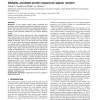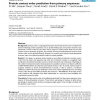102 search results - page 8 / 21 » Using constraint programming for lattice protein folding |
BIOINFORMATICS
2010
13 years 8 months ago
2010
Motivation: To test whether protein folding constraints and secondary structure sequence preferences significantly reduce the space of amino acid words in proteins, we compared th...
ISMB
1997
13 years 9 months ago
1997
The structural comparison of proteins has become increasingly important as a means to identify protein motifs and fold families. In this paper we present a new algorithm for the c...
NAR
2008
13 years 7 months ago
2008
MALISAM (manual alignments for structurally analogous motifs) represents the first database containing pairs of structural analogs and their alignments. To find reliable analogs, ...
BMCBI
2008
13 years 7 months ago
2008
Background: Post translational modifications (PTMs) occur in the vast majority of proteins and are essential for function. Prediction of the sequence location of PTMs enhances the...
BMCBI
2008
13 years 7 months ago
2008
Background: Contact order is a topological descriptor that has been shown to be correlated with several interesting protein properties such as protein folding rates and protein tr...


